French Dictionaries
Introduction
Antidote’s French dictionaries contain a wealth of information on all aspects of the French language: the meaning of words and idioms, pronunciation, spelling variants, synonyms, conjugations, semantic fields, combinations, etymologies and more.
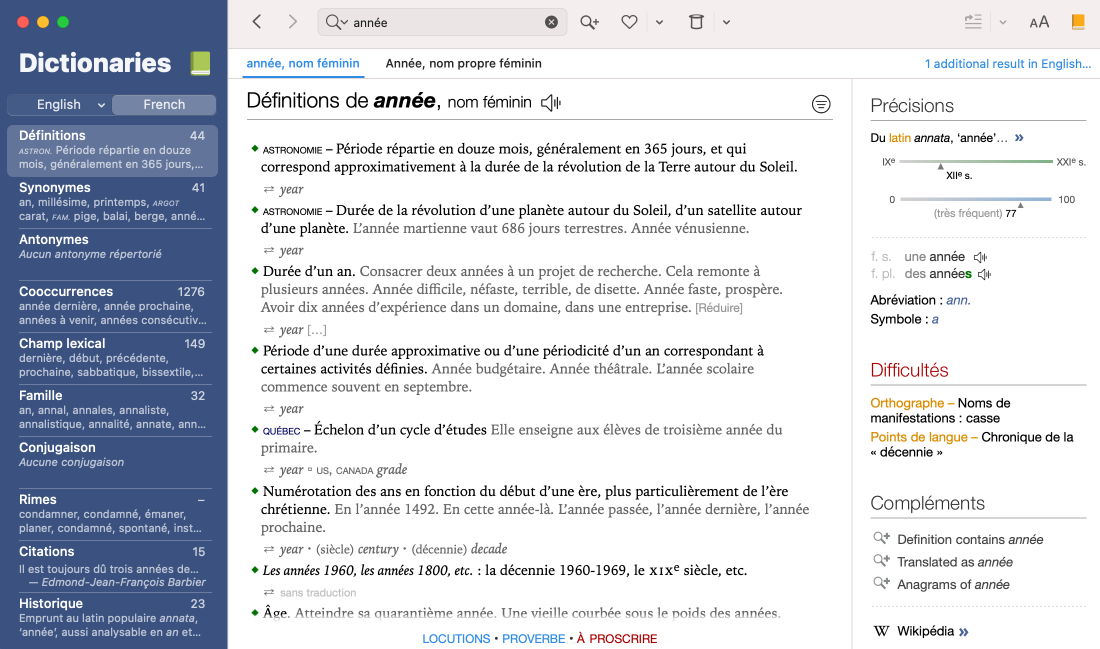
Accessing the French dictionaries

Antidote opens its French dictionaries automatically when you type a non-ambiguous French word in the headword search field. You can also open them yourself from any of the English dictionaries by clicking the French button located above the list of dictionaries. This will take you from an English word to the corresponding entry for its French translation. If many translations exist for the word, a chevron to the right of the French button will appear, which you can click to select the entry you would like to view. The default translation shown is the most frequent one.
- A setting in the General Panel of the Interface Settings changes how the French | English buttons work. They can be set to search for a word in the other language rather than translating it; you can also do this by holding down Alt and clicking the button.
Instant search menu

The instant search menu appears as soon as you start typing in the headword search field and displays a list of the most relevant search results. For many expressions, Antidote’s dictionaries also contain results in the other language; to see them, just click Show French results (when searching the English dictionaries) or Show English results (when searching the French dictionaries) at the bottom of the menu.
Homographs bar
When the headword has homographs, like the word force, which is a noun, a verb, and a plural determiner in French, they are displayed in the homographs bar located above the header for all dictionaries. For some dictionary searches, results exist in both languages; a blue link (x additional results in French or x additional results in English) at the far right of the homographs bar lets you view the results in the other language.

Dictionary of definitions (Définitions)

This dictionary provides definitions for more than one hundred thousand French words, in addition to tens of thousands of expressions, idioms and proverbs. The structure of the French definitions is similar to those in the English dictionary: the entries are divided into meanings, sub-meanings and semantic divisions, with examples provided in grey. There are, however, some notable differences.
- All definitions in the French dictionary begin with a capital letter.
- The examples are separated by a period and begin with a capital letter, regardless of whether they are grammatically complete sentences.
- Domain labels (e.g. ÉCONOMIE, DROIT, CINÉMA, MUSIQUE) appear in black and usage labels appear in blue (e.g. SOUTENU, ARGOT, FAMILIER, VIEILLI) or in red (e.g. OFFENSANT, DIFFAMATOIRE, PÉJORATIF). The usage labels indicating the region or regions where a particular word meaning is used (e.g. QUÉBEC, SUISSE, ANTILLES, AFRIQUE, BELGIQUE) are also displayed in blue. As in the English version, clicking a usage label opens the article in Antidote’s guides where it is described in full.
In many cases, especially when the word being looked up is common, the meanings and sub-meanings are accompanied by example expressions. These are categorized and presented as follows:
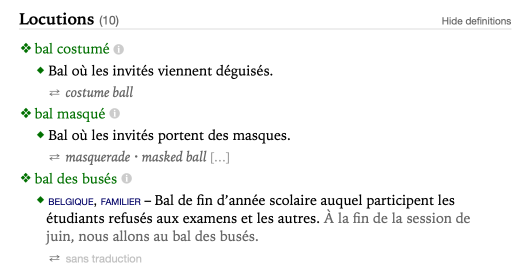
- Expressions are displayed in blue or black text, and you can quickly expand or collapse the definition by clicking the hide/show chevron. Click an expression in blue to consult its entry in the dictionaries and learn more about it (synonyms, combinations, quotations, etc.). Expressions in black provide additional information on their use: inflections, notes, external resources, etc. Click the icon to display the information in a tooltip.

-
Proverbs, i.e. sayings that are often short and purport to state a general truth or provide a piece of advice, e.g. Qui ne risque rien n’a rien, which is equivalent to the English Nothing ventured, nothing gained.
-
Non-standard constructions, usually consisting of literal translations from English or other improper uses. These constructions are shown in red to highlight the fact that they are incorrect.
Translations
Every definition of every word and expression is accompanied by a translation, both from French to English and from English to French. These translations can be hidden by clicking the Hide translations toggle in the menu under the configuration button (). When displayed, translations appear in italic grey text under each definition and are preceded by a ⇄ symbol.
-
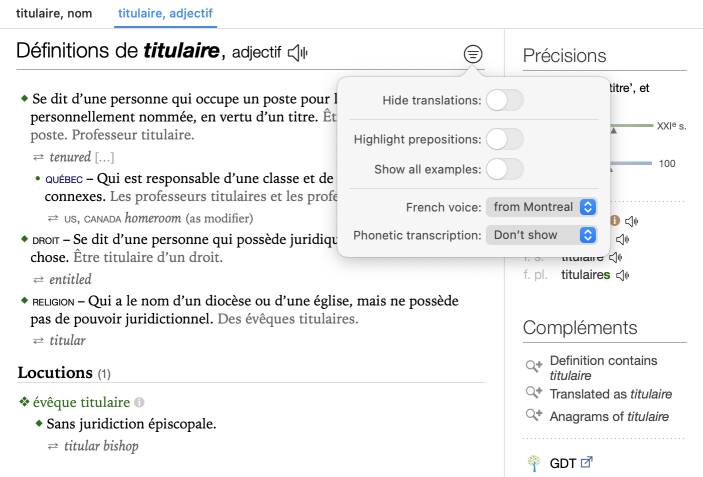 12
12
For example, in the French adjective entry titulaire, each of the three definitions has its own translation. In the context of religion (fourth definition), the English translation is titular. Clicking this translation once will cause a tooltip to appear showing the religion-specific English definitions of titular. This allows users to compare the French definitions with the English ones. Double-clicking the translation will open the English entry for the word in question.

Expressions and proverbs are also translated. As such, in the Locutions section of the entry titulaire, the expression évêque titulaire is accompanied by the translation titular bishop.

Formulations — Some translations are preceded by formulations in the source language, shown in roman type and followed by a colon. These formulations show the headword as part of a particular expression or construction. For example, one of the translations of the French entry embarcation is shown as “embarcation de sauvetage : lifeboat”. This shows users the full expression corresponding to one of the principal translations of the noun embarcation.

Usage contexts — Some translations are preceded by an indication of the context to which they apply, shown between parentheses and in roman type. For example, the first definition of the French word abattre can have a number of appropriate English translations depending on the context. Accordingly, many of the translations include contexts such as “(arbre) fell”.

Usage labels — Usage labels accompany translations whenever appropriate. For example, the informal French verb faucher includes the translations snatch and nab, preceded by an INFORMAL label. In general, Antidote provides translations that match in register to the word in the source language.

Connected translations Certain lists of translations are followed by an ellipsis enclosed in square brackets, indicating that connected translations are available. They can be revealed by clicking the ellipses and are displayed in a lighter grey font. These translations are generally less relevant than the principal translations for a number of reasons, such as relative rarity, a difference in register, or a more restricted meaning. Still, they may be useful in certain contexts. For example, the first definition of the French verb dépasser includes a number of connected translations, some of which are informal or specific to a particular region. To hide the list of connected translations, simply click the ellipsis again.
Details panel
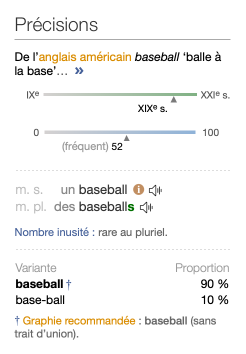
Under Précisions in the Details panel (right-hand panel), you will find:
- Etymological notes on the headword and the icon, which links to the historical dictionary where you can find more information on the headword’s etymology.
- A scale indicating the relative frequency of the headword in French.
- Inflection information: If the headword has more than one form (noun, adjective, pronoun, etc.), Antidote displays its inflections for the masculine, feminine, singular and plural. Inflections for nouns begin with the determiner un, une or des, so they can be interpreted intuitively. For verbs, Antidote shows the infinitive form (e.g. avoir), as well as the tense, mood and person if a conjugated form is looked up (e.g. avais).
- The phonetic transcription of the headword and its inflected forms, if applicable. An option in the configuration button allows you to switch between two different phonetic transcriptions, the International Phonetic Alphabet (Show IPA) and the French phonetic alphabet (Show FPA). Another option lets you display syllabic splitting.
- Alternative spellings of the word.
If the headword is subject to the 1990 French spelling rectifications, Antidote displays a note with the rectified spelling (e.g. flute, rectified spelling of flûte). In the case of a word with alternative spellings, one of which is recommended by the rectifications, a blue dagger symbol (†) highlights the recommended spelling (e.g. baseball, recommended without a hyphen).
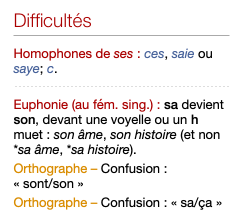
Under the Difficultés heading, you will find:
- An explanation of any linguistic difficulties (grammar, spelling, syntax or other) related to the use of the headword.
Under the Compléments heading, you will find:
- Predefined search criteria (definitions containing the headword, English words translated as the headword, anagrams and compound words containing the headword)
- More search tools (e.g. the Wikipedia encyclopedia and the Google search engine), which can be enabled in the settings. Other online linguistic resources can be added manually.
Dictionary of synonyms (Synonymes)

Antidote’s dictionary of French synonyms is a treasure trove of information, offering hundreds of thousands of synonyms that express myriad shades of meaning and semantic association. In it, you will find:
- The headword’s main meanings, each preceded by a green hide/show chevron.
- Further information on meaning or use, preceded by a bold green bullet (•)
- Labels in small caps indicating the context in which the synonyms they introduce may be employed. These are divided into domain labels in black (e.g. ALIMENTATION, CHASSE, INFORMATIQUE, MÉDECINE), and usage labels in blue (e.g. SOUTENU, FAMILIER, ARGOT, VIEILLI) or in red (e.g. OFFENSANT, PÉJORATIF). The usage labels indicating the region or regions where a synonym is used (e.g. BELGIQUE, QUÉBEC, FRANCE) are also displayed in blue. Clicking a usage label opens the article in the Antidote guides where it is described in full.
- Hyperonyms and hyponyms, identified by the headings PLUS GÉNÉRIQUE (more general), PLUS SPÉCIFIQUE (more specific). The lists of hyperonyms and hyponyms are preceded by a solid green square (◼︎). A small blue circle with a number indicates either that a hyponym has hyponyms of its own, or that a hyperonym has hyperonyms of its own. Clicking that circle will reveal these secondary hyponyms (shown with a right-pointing arrow) or hyperonyms (shown with a left-pointing arrow) in a list. The same process can be repeated should any of the newly revealed words have their own hyponyms or hyperonyms. A list can be hidden again by clicking the arrow.
- Contexts in grey and in parentheses specifying the circumstances in which a synonym is used (e.g. “louve (femelle)” as a synonym of the word loup).
Sorting the synonyms
According to your needs, you can sort synonyms four ways: alphabetically, by relevance, by frequency or by length (number of letters). Access the sorting options by clicking the configuration button ().
Filters
You can also filter synonyms according to two criteria by clicking the configuration button ().
The Meaning filter lets you display synonyms according to their semantic or expressive strength (strong, weak or neutral). By default all synonyms are displayed.
The With labels filter lets you display only words without usage or domain labels to be shown. By default it shows everything.
Dictionary of antonyms (Antonymes)
Like the English dictionary of antonyms, Antidote classifies French antonyms according to the meaning in question, making it easier for you to select the proper term. Click the hide/show chevrons (for each list or for the whole entry) to switch between exhaustive and summary views.
Dictionary of combinations (Cooccurrences)
The dictionary of combinations (called cooccurrences in French) displays all the most significant combinations of the headword with other words. These are grouped by syntactic context, in addition to the strength of each combination and, if applicable, the various meanings of the headword.

For the noun feu (“fire”), for example, you will find combinations like jouer avec le feu, combattre le feu avec le feu, feu de camp, feu purificateur, feu et sang, feu sacré, le feu s’éteint, péter le feu and hundreds of others. Some word combinations, like feu sacré, are also expressions with their own entries in the dictionaries, which you can consult. Click the icon to open the dictionary of combinations on the entry for the corresponding expression.
French combinations are displayed similarly to the entries in the English dictionary of combinations, except for the following differences:
- The syntactic contexts are adapted to French grammar and include classes that don’t appear in the English dictionary, e.g. avec nom complément (“with noun complement”), avec adjectif descriptif (“with descriptive adjective”), en apposition (“in apposition”).
- The List of sources link takes you to a list of all the French texts used to build the dictionary of combinations.
Labels
If a combination belongs to an informal register, a usage label (FAMILIER or TRÈS FAMILIER) is shown to its right. If a usage label applies to all combinations for a given meaning of the headword, it is not repeated next to each combination; instead, it is shown next to the heading that indicates the meaning.
Translations
When the French Module is installed, each of the combinations shown in both the English and the French dictionaries includes a translation into the other language. To show or hide the Translation column, click the ⇄ button located in the title bar. For example, for the French word eau, the combination eau potable includes the translation drinking water. If a combination includes a second translation, it is separated from the first by a middle dot. For example, for the combination eaux usées the Translation column shows “wastewater • sewage”.
Examples and definitions — Whenever the translation of a combination is itself included in the other language’s dictionary of combinations, as is the case with drinking water, a > symbol appears to its right. Click a combination’s translation to display any examples or definitions associated with it in the right-hand panel. Click the buttons at the bottom of this panel to switch between examples and definitions. When the translation does not exist as a combination in the other language, no > symbol is displayed and clicking the translation will display only definitions of its constituent words in the right-hand panel. For example, water for washing is the translation of the French combination eau pour laver. Since water for washing does not feature in Antidote’s English combinations, clicking it displays the definitions for the words water and washing.
Search — When the Traduction column is displayed, the search field at the bottom of the main combinations panel lets you search both the combinations and their translations for a given keyword or character string.
Sorting — Click the title of the Traduction column to sort the translations in alphabetical order.
Dictionary of semantic fields (Champ Lexical)

The French dictionary of semantic fields displays all the French words that are semantically related to the headword. These are grouped by syntactic category (nouns, adjectives, verbs) and ranked by relative strength.
Dictionary of families (Famille)

The French dictionary of families presents all the words in the headword’s morpho-semantic family. When the headword has multiple meanings that are sufficiently distinct, a horizontal grey line separates the families related to each.
Dictionary of conjugations (Conjugaison)

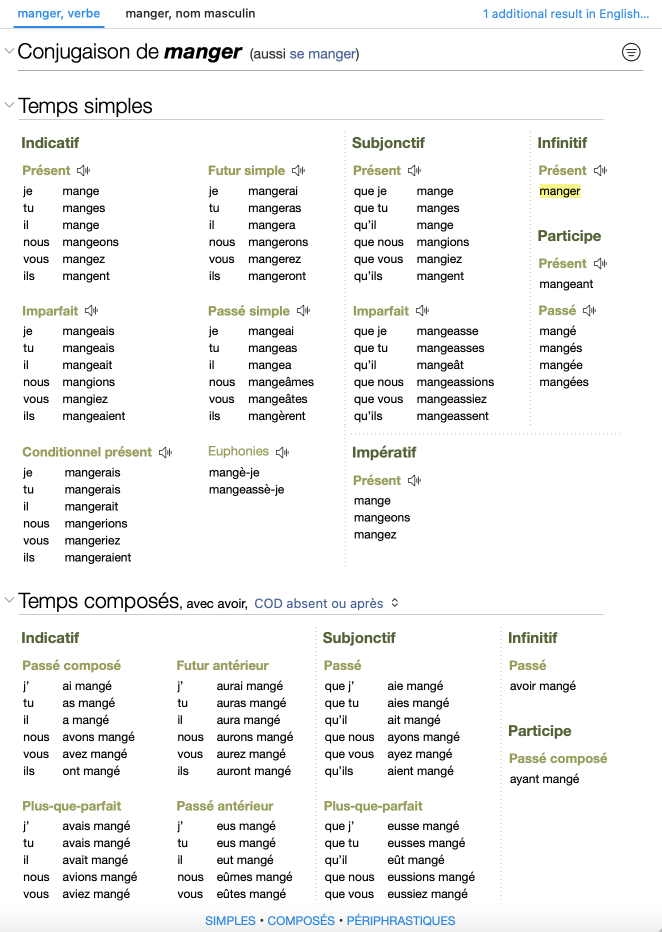
Antidote’s French dictionary of conjugations provides all the conjugations for several thousand French verbs. The dictionary displays a complete conjugation table for each verb that includes all the conjugated forms in all the tenses and moods, both for the simple form of the verb and the pronominal form (if it exists). The verb form typed in the headword search field is highlighted in the table to make it easier to find. Click one of the verb forms in the table to select it, then click the button to insert it into your text. To make it easier to consult the table, the numerous conjugated forms are grouped into simple tenses (temps simples); compound tenses (temps composés), including the auxiliary with which the verb is conjugated; and periphrastic tenses (temps périphrastiques).
For compound tenses, the menu next to the section title lets you display the different agreements of the past participle according to the position, gender and number of the complément d’objet direct (COD), if applicable, or according to the gender and number of the subject. (Choose a masculine or feminine subject by clicking the configuration button in the top right corner of the main panel and changing the corresponding setting.) The COD menu is only available for verbs with variable past participles; otherwise Antidote shows PP invariable. To learn more about past participle agreement, you can click the link to the guides in the yellow Notes box.
You can display the phonetic transcription for conjugated forms by way of the button in the top right corner of the window. You can also change the phonetic alphabet used by choosing from the options under Phonetic transcription.
Click the to hear all pronunciations for a given verb tense, like in school, which can help you learn a conjugation by rhythmic memory. To hear one form in particular, click its transcription.
- Pronunciation requires a valid subscription.
- If audio pronunciation is available, Antidote displays the icon. You can hide it as needed by adjusting your settings (Interface > Access Control > Audio Content).
- The phonetic transcription displayed takes your linguistic region into account, as it is defined in the User Panel of the Language Settings.
Dictionary of rhymes (Rimes)
Like its English counterpart, the French dictionary of rhymes presents words and expressions that rhyme with the headword. Results are presented the same way: according to the number of identical phonemes. Both languages offer a similar set of display options, although there are some key differences.

While the English dictionary of rhymes displays only perfect rhymes by default, this concept does not exist in French. Therefore all rhymes are shown for French by default, with an option to expand the search to near-rhymes (quasi-rimes) in the options panel. The types of near-rhyme displayed in French are the same as those in English.
The French dictionary of rhymes includes a Gender filter, a concept unrelated to grammatical gender. In French classical poetry, French words that end in a silent e (for example, in the verb endings -e, -es and -ent) are known as feminine. Other words are known as masculine. French classical poetry forbids the rhyming of words of a different gender, for example antidote [âtidòt] with dot [dòt]. The Gender filter allows results to be filtered by their gender, helping users respect the conventions of classical poetry if they wish.
Dictionary of quotations (Citations)

To illustrate how the words of the language are actually used, the French dictionary of quotations offers a vast compilation of sentences taken from great authors and major newspapers. Each quote is accompanied by a hyperlink to its source on the Internet.
Historical dictionary (Historique)


The historical dictionary provides detailed etymologies for a large number of words, accompanied in most cases by a hierarchical list of etymologically related words (Parents étymologiques) and often supplemented with explanatory notes.
Entries in the French historical dictionary are divided into the following components:
- The etymology of the headword, including at least the etymon (i.e. the word from which the headword is derived), its meaning and the language from which it derives (in orange and linked to an article in the historical guides). Other information may be provided, e.g. whether the headword belongs to the native stock of the language (fonds primitif), the influence of a second etymon on the main etymon, the apparent (morphological) etymology of a derived form, etc. For some words whose etymology is complex or very interesting, an explanatory note may provide further information.
- The etymologically related words (Parents étymologiques), beginning with the main etymon, form a sort of family tree that traces the word’s evolution. For example, for the French word texture (from the classical Latin texere, “to weave”), the etymologically related words include the Old French tistre (which gave rise to the French noun tissu), the Middle French tissir (from which the modern French verb tisser is derived), the medieval Latin textualis (from which modern French gets the adjective textuel), etc. All these words share a common etymon: the Latin verb texere. To clarify the list of etymologically related words, a simple line of ascendance is also included, which indicates sequentially, from the oldest etymon to the most recent, the major steps in the headword’s evolution. The arrow can be read as meaning “gave rise to, produced, formed”.
- Historical changes in the spelling of over 26,000 words, from their origins to the present day, presented on a timeline and attested by 275,000 sentences gathered from historical sources. Using this, we discover that azote “nitrogen”, for instance, was coined by Lavoisier from Greek affixes meaning “not” and “life”, and that fleur “flour” was written as both fleur and flour until the 17th century.
Remember: a summary of the word’s etymology appears in the Précisions panel in the definitions dictionary, where clicking the icon lets you access the historical dictionary.
Accessing Wikipedia

You can access the French version of Wikipedia, the famous online encyclopedia, by clicking the Wikipédia link in the Compléments section of the Details panel. When applicable, you can also access it by clicking the link in the pop-up that appears when you click the icon found to the right of many expressions in the French dictionaries. Access to Wikipedia or to sensitive content therein can be restricted in your settings. Antidote displays the results from Wikipedia directly in the dictionary window. The hyperlink in English in the upper right corner of the article lets you switch to the English version of the article, if it exists in Wikipedia. Conversely, an article that is displayed in English will include the hyperlink in French.
Multi-word search
Like its English counterpart, French multi-word search allows you to search for complex expressions in the dictionaries. This feature makes it easy to find links between words, like those that occur in expressions, combinations, proverbs, etc.

Searching with variables
Searching with variables in French is very similar to searching with variables in English.

Searching by criteria
Search by criteria is a powerful tool that lets you make the most of the vast stores of information in Antidote’s French dictionaries. The same tools are offered for searching by criteria in French as in English, and they are accessed in the same way for both languages. For the most part, the search criteria are also the same in both languages; you can search by word, category, definition, domain, encyclopedic information, number of letters, number of syllables, frequency, rhyme, register, grammatical number, positive/negative, strong/weak, proverb, translation, language of origin and compound word. The criteria gender and rectified spelling are added in French.
Searches in French include an extra option in the Forms section that requires accented characters in the results to exactly match those in the search term (exact accents), in addition to an option for displaying all inflected forms in the results (inflections) and for including spaces in the results (with spaces).
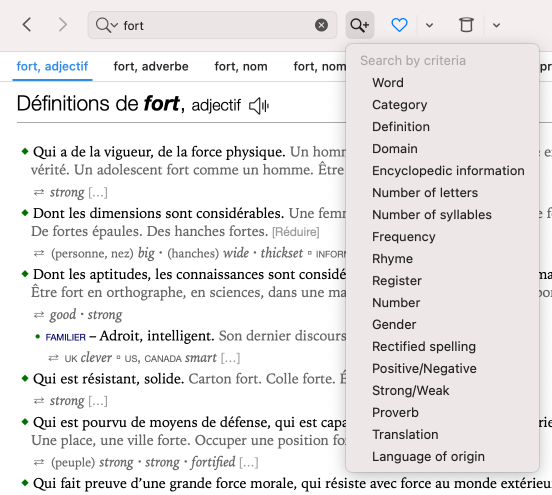
Favourites and personalized word lists

You can add and remove favourites and personalized word lists the same way in both the English and the French dictionaries (see the Dictionaries chapter). Click the chevron beside the icon and select Edit to open the Favourites window. English and French lists are displayed separately, and you have several options for managing them. Select Also in English/French from the drop-down menu to switch between your English and French word lists.
Discovering new words
By clicking the Discover () icon, you can discover and learn new French words—both common and rare—in addition to the names of famous people, countries, cities or World Heritage sites, and read interesting notes about French etymology.